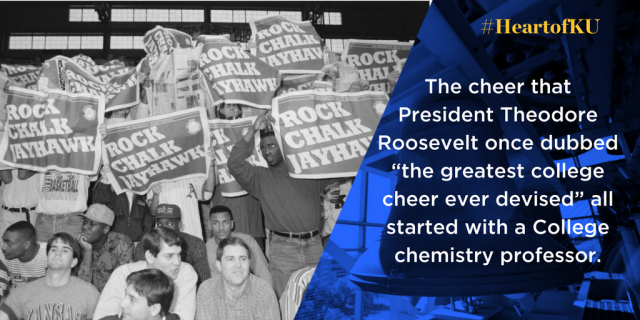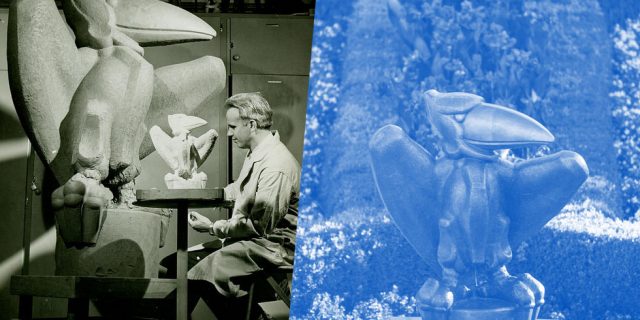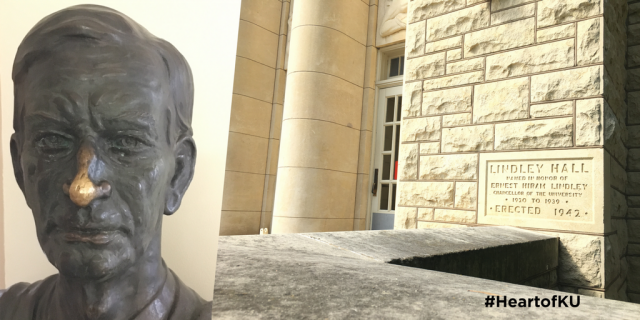The College: The heart of KU traditions
Jayhawks love their traditions. They unite our community, connect us to our past, and capture the values that will propel us to greatness. But did you know that several of the most famous KU traditions were born out of the creativity of College faculty and alumni? From the Rock Chalk Chant to good luck charms, here's some of the reasons why the College is known as the historical heart of KU.
Rock Chalk Chant

The cheer that President Theodore Roosevelt once dubbed “the greatest college cheer ever devised” all started with a chemistry professor. In 1886, KU’s Science Club was trying to create a cheer. E. H. S. Bailey (namesake of Bailey Hall), suggested the phrase “Rah, Rah, Jay Hawk, KSU.” The club adopted Professor Bailey’s cheer and it soon became popular among the whole student body. Not long after, about a year, the chant became what it is today: “Rock Chalk.” Although the exact authors of the alteration are unknown, Bailey gave credit to geology professors, inspired by the “chalk rock” found throughout Kansas and Mount Oread.
The 1912 Jayhawk

The first Jayhawk recognized by the university was drawn by a student in the College, Henry Maloy. Maloy’s illustration first appeared in the University Daily Kansan and then the Jayhawker Yearbook. Although students and faculty began to identify as Jayhawks starting in 1866 with the first iteration of the Rock Chalk Chant, there was no university-endorsed version of the mythical bird until Maloy’s illustration. In fact, the football team was known to use a pit bull or a pig as its mascot in the early 20th century. Although Maloy’s version didn’t last as the official Jayhawk, it can be credited as the first version to feature shoes, a trait all other versions, except the 1920 Jayhawk, shared. Maloy graduated from the College in 1914.
“Academic Jay” and “Moses”

Elden Tefft, a professor of art at KU for 40 years, sculpted two of the most recognizable sculptures on campus. The “Academic Jay,” which currently stands outside Strong Hall was commissioned by the Class of 1956. Tefft said he was inspired by the “fighting Jayhawks” that were mascots from 1929 to 1946. The sculpture was placed at sites near the Kansas Union first, then moved to Strong Hall at the suggestion of Chancellor Archie Dykes in 1975. Another iconic sculpture created by Tefft brings the University of Kansas seal to life in three dimensions. Tefft created the “Moses” sculpture outside Smith Hall. It’s sited in front of the “Burning Bush” stained-glass window, with the Moses sculpture kneeling before it, much like the scene depicted in the university’s seal. Fire symbolizes knowledge in many stories and myths. Moses is thought to represent the humble attitude of the scholar who recognizes the unquenchable nature of the pursuit of truth and knowledge. The sculpture was dedicated in 1982.
Good Luck Charm

As anxiety mounts on campus before finals week, students employ a variety of rituals and good luck charms to boost their confidence. One of the most popular may be rubbing the nose on the bust of Chancellor Ernest H. Lindley. The sculpture was placed in the late 1950s, commissioned by leftover money from the class of 1929. In 1969, the Lawrence Journal-World first reported on the tradition of rubbing the former chancellor’s nose for good luck. The tradition is so popular that the nose has been replaced seven times, each time after the nose has been rubbed to the point it becomes much shinier than the rest of the bronze sculpture. The bust sits, fittingly, in Lindley Hall, home to the College’s Departments of Geology, Geography & Atmospheric Science, and Environmental Studies.